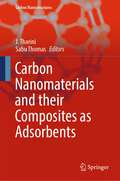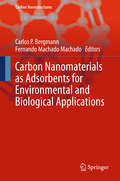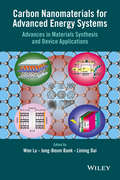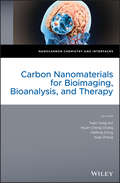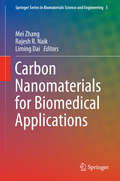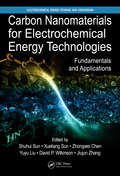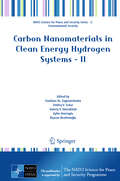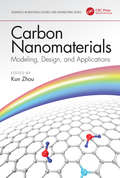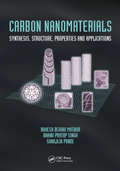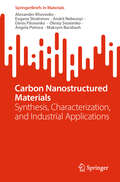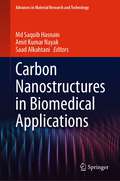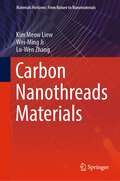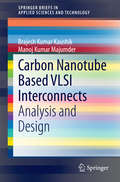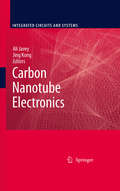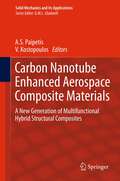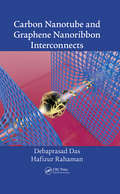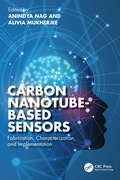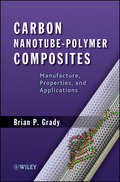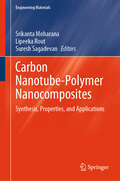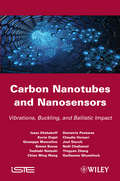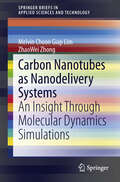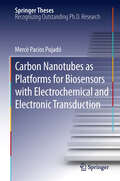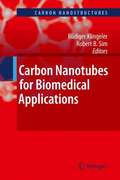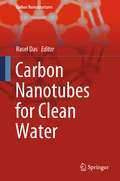- Table View
- List View
Carbon Nanomaterials and their Composites as Adsorbents (Carbon Nanostructures)
by Sabu Thomas J. ThariniThis book elucidates fundamental concepts of nanomaterials and their pivotal role as nanoadsorbents in water purification. Key features include the latest trends in adsorption for metal, micro pollutants, food adulterants, aromatic compounds, pesticides, dyes, and oil particle removal. Additionally, the interdisciplinary aspects of adsorption and practical applications for hazardous chemical removal from water are explored. The book delves into various types of adsorption isotherms such as Langmuir, Freundlich, BET, and others, offering a deep understanding for water purification. Kinetic models including first, second, and third order kinetics are elucidated, empowering undergraduate students to grasp and optimize complex systems. The required background is basic knowledge in chemistry, biology, mathematics, and nanoscience at the first-year university level. Designed for both academics and industrial researchers, this book is divided into 17 chapters. Chapters 1-7 introduce nanomaterials, carbon nanoadsorbents, their synthesis, and surface modification. Chapters 8-9 cover fundamental adsorption isotherms, kinetic models, thermodynamic parameters, adsorption mechanism, and experimental techniques. Chapters 10-15 delve into the adsorption and desorption of various compounds like aromatic compounds, pesticides, heavy metals, micro pollutants, food adulterants, oil particles, and dyes molecules. The final chapter tackles the theoretical modeling of carbon nanomaterials for adsorption studies
Carbon Nanomaterials as Adsorbents for Environmental and Biological Applications (Carbon Nanostructures)
by Carlos P. Bergmann Fernando Machado MachadoThis book presents a summary of the current use of carbon nanomaterials for water treatment, drug delivery, systems and nanosensors. The first chapter elucidates the adsorption process phenomenon. Also, the properties of different carbon nanomaterials for adsorption applications are covered. The third chapter presents the kinetic and equilibrium models of adsorption, processing of experimental data and adsorption process peculiarities. Environmental and biological applications of carbon nanomaterials are listed in the last chapter. This book is written from an application-oriented perspective and is useful for all those interested in nanoadsorbents.
Carbon Nanomaterials for Advanced Energy Systems
by Liming Dai Jong-Beom Baek Wen LuWith the proliferation of electronic devices, the world will need to double its energy supply by 2050. This book addresses this challenge and discusses synthesis and characterization of carbon nanomaterials for energy conversion and storage. Addresses one of the leading challenges facing society today as we steer away from dwindling supplies of fossil fuels and a rising need for electric power due to the proliferation of electronic products Promotes the use of carbon nanomaterials for energy applications Systematic coverage: synthesis, characterization, and a wide array of carbon nanomaterials are described Detailed descriptions of solar cells, electrodes, thermoelectrics, supercapacitors, and lithium-ion-based storage Discusses special architecture required for energy storage including hydrogen, methane, etc.
Carbon Nanomaterials for Bioimaging, Bioanalysis, and Therapy (Nanocarbon Chemistry and Interfaces)
by Xueji Zhang Haifeng Dong Yuen Y. Hui Huang-Cheng ChangA comprehensive reference on biochemistry, bioimaging, bioanalysis, and therapeutic applications of carbon nanomaterials Carbon nanomaterials have been widely applied for biomedical applications in the past few decades, because of their unique physical properties, versatile functionalization chemistry, and biological compatibility. This book provides background knowledge at the entry level into the biomedical applications of carbon nanomaterials, focusing on three applications: bioimaging, bioanalysis, and therapy. Carbon Nanomaterials for Bioimaging, Bioanalysis and Therapy begins with a general introduction to carbon nanomaterials for biomedical applications, including a discussion about the pros and cons of various carbon nanomaterials for the respective therapeutic applications. It then goes on to cover fluorescence imaging; deep tissue imaging; photoacoustic imaging; pre-clinical/clinical bioimaging applications; carbon nanomaterial sensors for cancer and disease diagnosis; targeted cancer therapy; and photothermal/photodynamic therapy. Each chapter briefly introduces the biomedical application and emphasizes the most appropriate carbon nanomaterial(s) for the application. Provides an introduction to the biomedical applications of carbon nanomaterials for early-career scientists, as well as background and context for mid-career scientists and researchers Contains four sections covering biochemistry, bioimaging, bioanalysis, and therapeutic applications of carbon nanomaterials Presented by experts who have strong background in the field of nanotechnology for biomedical applications Covers a hot area of research which has very unique physical properties, versatile functionalization chemistry, and biological compatibility Carbon Nanomaterials for Bioimaging, Bioanalysis and Therapy is an excellent resource for academic researchers and industrial scientists working on preparation and bio-application of carbon nanomaterials, biomedical engineering, and nanotechnology.
Carbon Nanomaterials for Biomedical Applications (Springer Series in Biomaterials Science and Engineering #5)
by Liming Dai Mei Zhang Rajesh R. NaikThis book covers a wide range of topics relating to carbon nanomaterials, from synthesis and functionalization to applications in advanced biomedical devices and systems. As they possess unique and attractive chemical, physical, optical, and even magnetic properties for various applications, considerable effort has been made to employ carbon nanomaterials (e. g. , fullerenes, carbon nanotubes, graphene, nanodiamond) as new materials for the development of novel biomedical tools, such as diagnostic sensors, imaging agents, and drug/gene delivery systems for both diagnostics and clinical treatment. Tremendous progress has been made and the scattered literature continues to grow rapidly. With chapters by world-renowned experts providing an overview of the state of the science as well as an understanding of the challenges that lie ahead, Carbon Nanomaterials for Biomedical Applications is essential reading not only for experienced scientists and engineers in biomedical and nanomaterials areas, but also for graduate students and advanced undergraduates in materials science and engineering, chemistry, and biology.
Carbon Nanomaterials for Electrochemical Energy Technologies: Fundamentals and Applications (Electrochemical Energy Storage and Conversion)
by Jiujun Zhang Xueliang Sun Zhongwei Chen David P. Wilkinson Yuyu Liu Shuhui SunThis book offers comprehensive coverage of carbon-based nanomaterials and electrochemical energy conversion and storage technologies such as batteries, fuel cells, supercapacitors, and hydrogen generation and storage, as well as the latest material and new technology development. It addresses a variety of topics such as electrochemical processes, materials, components, assembly and manufacturing, degradation mechanisms, challenges, and strategies. With in-depth discussions ranging from electrochemistry fundamentals to engineering components and applied devices, this all-inclusive reference offers a broad view of various carbon nanomaterials and technologies for electrochemical energy conversion and storage devices.
Carbon Nanomaterials in Clean Energy Hydrogen Systems - II (NATO Science for Peace and Security Series C: Environmental Security)
by Ayfer Veziroğlu Beycan İbrahimoğlu Dmitry V. Schur Svetlana Yu. Zaginaichenko Valeriy V. SkorokhodThis book presents selected contributions to the NATO Advanced Research Workshop "Carbon Nanomaterials in Clean Energy Hydrogen Systems" held in June 2010. These original papers reflect recent progress in response to the modern-day requirements in chemistry of carbon nanomaterials and metal-hydrogen systems. Successor to the 2008 proceedings, this second volume focuses on research and application studies of materials capable of interacting actively with hydrogen, also addressing questions of hydrogen accumulation and storage. As a whole, it provides a review of the most relevant areas of hydrogen materials interactions and carbon nanomaterials science, making it invaluable for all researchers, physicists, chemists, post-graduates and young scientists interested in the structure, properties and applications of different nanocarbon materials.
Carbon Nanomaterials: Modeling Design And Applications (Advances in Materials Science and Engineering)
by Kun ZhouCarbon Nanomaterials: Modeling, Design, and Applications provides an in-depth review and analysis of the most popular carbon nanomaterials, including fullerenes, carbon nanotubes, graphene and novel carbon nanomaterial-based membranes and thin films, with emphasis on their modeling, design and applications. This book provides basic knowledge of the structures, properties and applications of carbon-based nanomaterials. It illustrates the fundamental structure-property relationships of the materials in both experimental and modeling aspects, offers technical guidance in computational simulation of nanomaterials, and delivers an extensive view on current achievements in research and practice, while presenting new possibilities in the design and usage of carbon nanomaterials. This book is aimed at both undergraduate and graduate students, researchers, designers, professors, and professionals within the fields of materials science and engineering, mechanical engineering, applied physics, and chemical engineering.
Carbon Nanomaterials: Synthesis, Structure, Properties and Applications
by Rakesh Behari Mathur Bhanu Pratap Singh Shailaja PandeThe study of nanostructures has become, in recent years, a theme common to many disciplines, in which scientists and engineers manipulate matter at the atomic and molecular level in order to obtain materials and systems with significantly improved properties. Carbon nanomaterials have a unique place in nanoscience owing to their exceptional thermal, electrical, chemical, and mechanical properties, finding application in areas as diverse as super strong composite materials, energy storage and conversion, supercapacitors, smart sensors, targeted drug delivery, paints, and nanoelectronics. This book is the first to cover a broad spectrum of carbon nanomaterials, namely carbon nanofibers, vapor-grown carbon fibers, different forms of amorphous nanocarbons besides carbon nanotubes, fullerenes, graphene, graphene nanoribbons, graphene quantum dots, etc. in a single volume.
Carbon Nanostructured Materials: Synthesis, Characterization, and Industrial Applications (SpringerBriefs in Materials)
by Maksym Barabash Alexander Khovavko Eugene Strativnov Andrii Nebesnyi Denis Filonenko Olexiy Sviatenko Angela PiatovaThis book provides a concise yet comprehensive look at carbon nanostructured materials, focusing on synthesis methodologies, applications, and fundamental principles. Based on extensive research conducted at the Gas Institute of the National Academy of Sciences of Ukraine, it offers a thorough examination of recent advancements in the field. The book describes various synthesis techniques, particularly emphasizing the continuous synthesis of carbon nanotubes (CNTs) on metal catalysts using chemical vapor deposition (CVD). It also discusses computational fluid dynamics (CFD) modeling of heating processes associated with carbon materials, crucial for understanding the thermodynamics of complex gas systems relevant to CNTs synthesis. Furthermore, the book discusses the structural properties of carbon nanomaterials, employing techniques such as Raman spectroscopy and optical microscopy. It provides detailed insights into the design and optimization of modern equipment for CNTs synthesis, with a focus on energy-efficient reactors for thermally expanded graphite (TEG) production. Beyond synthesis methodologies, the book explores applications of carbon nanomaterials, including their use in lithium-ion batteries, water purification systems, and nuclear reactors. It offers a serious examination of the potential environmental and technological implications of these materials. Comprising three distinct parts, each supplemented with comprehensive summaries, this book serves as a valuable resource for researchers, engineers, and graduate students in material science, thermal engineering, and nanotechnology. It presents empirical findings, theoretical insights, and practical applications, establishing itself as a valuable addition to the literature in the field of carbon nanostructured materials.
Carbon Nanostructures in Biomedical Applications (Advances in Material Research and Technology)
by Amit Kumar Nayak Md Saquib Hasnain Saad AlkahtaniThis book provides a holistic compilation on applications of carbon nanostructures, especially in advanced healthcare applications. It comprises chapters on utility of diverse multifunctional nanocarriers in drug delivery and biomedical applications, especially emphasizing on the synthesis and characterizations of nanosystems along with surface engineering approaches used for active targeting of the drugs. Moreover, the chapters also include the recent updates on the applications of the nanocarriers to fulfill the needs of various healthcare systems.
Carbon Nanothreads Materials (Materials Horizons: From Nature to Nanomaterials)
by Kim Meow Liew Wei-Ming Ji Lu-Wen ZhangThis book describes carbon nanothreads with complete and comprehensive knowledge covering theories, numerical methods, and properties comparisons with other carbon-based nanomaterials. For one thing, the main theoretical aspects in this book include: First-Principle Calculation, Density Functional Theory, Classical Molecular Dynamics Simulation, Non-equilibrium Molecular Dynamics Simulation, and Coarse Grained Simulation. For another thing, the main research contents include: Fundamental Mechanical Properties; Fracture Characteristics; Electronic and Magnetic Properties; Thermal Properties; Reinforcement in Polymer Composites; and other promising applications in engineering. The target of this book is to provide to many researchers the available theoretical and numerical methods, and useful computational results of carbon nanothreads for reference. This book can be used as a comprehensive source for scientists, academics, researchers, and engineers in various areas of engineering, physical sciences, and computational modeling. In order to achieve this target, the book introduces the microstructure information of carbon nanothreads and the modeling details at full length. The tunable mechanisms of physical properties of carbon nanothreads are discussed in detail, which enable integration of these nanoscale components into high-order structures for “bottom-up design” purpose. The revealed reinforced mechanisms of carbon nanothreads in polymer composites can provide theoretical guidance for engineering design of advanced polymer composites.
Carbon Nanotube Based VLSI Interconnects: Analysis and Design (SpringerBriefs in Applied Sciences and Technology)
by Brajesh Kumar Kaushik Manoj Kumar MajumderThe brief primarily focuses on the performance analysis of CNT based interconnects in current research scenario. Different CNT structures are modeled on the basis of transmission line theory. Performance comparison for different CNT structures illustrates that CNTs are more promising than Cu or other materials used in global VLSI interconnects. The brief is organized into five chapters which mainly discuss: (1) an overview of current research scenario and basics of interconnects; (2) unique crystal structures and the basics of physical properties of CNTs, and the production, purification and applications of CNTs; (3) a brief technical review, the geometry and equivalent RLC parameters for different single and bundled CNT structures; (4) a comparative analysis of crosstalk and delay for different single and bundled CNT structures; and (5) various unique mixed CNT bundle structures and their equivalent electrical models.
Carbon Nanotube Electronics (Integrated Circuits and Systems)
by Ali Javey Jing KongThis book provides a complete overview of the field of carbon nanotube electronics. It covers materials and physical properties, synthesis and fabrication processes, devices and circuits, modeling, and finally novel applications of nanotube-based electronics. The book introduces fundamental device physics and circuit concepts of 1-D electronics. At the same time it provides specific examples of the state-of-the-art nanotube devices.
Carbon Nanotube Enhanced Aerospace Composite Materials: A New Generation of Multifunctional Hybrid Structural Composites (Solid Mechanics and Its Applications #188)
by A. Paipetis V. KostopoulosThe well documented increase in the use of high performance composites as structural materials in aerospace components is continuously raising the demands in terms of dynamic performance, structural integrity, reliable life monitoring systems and adaptive actuating abilities. Current technologies address the above issues separately; material property tailoring and custom design practices aim to the enhancement of dynamic and damage tolerance characteristics, whereas life monitoring and actuation is performed with embedded sensors that may be detrimental to the structural integrity of the component. This publication explores the unique properties of carbon nanotubes (CNT) as an additive in the matrix of Fibre Reinforced Plastics (FRP), for producing structural composites with improved mechanical performance as well as sensing/actuating capabilities. The successful combination of the CNT properties and existing sensing actuating technologies leads to the realization of a multifunctional FRP structure. The current volume presents the state of the art research in this field. The contributions cover all the aspects of the novel composite systems, i.e. modeling from nano to macro scale, enhancement of structural efficiency, dispersion and manufacturing, integral health monitoring abilities, Raman monitoring, as well as the capabilities that ordered carbon nanotube arrays offer in terms of sensing and/or actuating in aerospace composites.
Carbon Nanotube and Graphene Device Physics
by H.-s. Philip Wong Deji AkinwandeThe medieval Norse-Icelandic saga is one of the most important European vernacular literary genres of the Middle Ages. This Introduction to the saga genre outlines its origins and development, its literary character, its material existence in manuscripts and printed editions, and its changing reception from the Middle Ages to the present time. Its multiple sub-genres - including family sagas, mythical-heroic sagas and sagas of knights - are described and discussed in detail, and the world of medieval Icelanders is powerfully evoked. The first general study of the Old Norse-Icelandic saga to be written in English for some decades, the Introduction is based on up-to-date scholarship and engages with current debates in the field. With suggestions for further reading, detailed information about the Icelandic literary canon, and a map of medieval Iceland, this book is aimed at students of medieval literature and assumes no prior knowledge of Scandinavian languages.
Carbon Nanotube and Graphene Nanoribbon Interconnects
by Hafizur Rahaman Debaprasad DasAn Alternative to Copper-Based Interconnect Technology With an increase in demand for more circuit components on a single chip, there is a growing need for nanoelectronic devices and their interconnects (a physical connecting medium made of thin metal films between several electrical nodes in a semiconducting chip that transmit signals from one point to another without any distortion). Carbon Nanotube and Graphene Nanoribbon Interconnects explores two new important carbon nanomaterials, carbon nanotube (CNT) and graphene nanoribbon (GNR), and compares them with that of copper-based interconnects. These nanomaterials show almost 1,000 times more current-carrying capacity and significantly higher mean free path than copper. Due to their remarkable properties, CNT and GNR could soon replace traditional copper interconnects. Dedicated to proving their benefits, this book covers the basic theory of CNT and GNR, and provides a comprehensive analysis of the CNT- and GNR-based VLSI interconnects at nanometric dimensions. Explore the Potential Applications of CNT and Graphene for VLSI Circuits The book starts off with a brief introduction of carbon nanomaterials, discusses the latest research, and details the modeling and analysis of CNT and GNR interconnects. It also describes the electrical, thermal, and mechanical properties, and structural behavior of these materials. In addition, it chronicles the progression of these fundamental properties, explores possible engineering applications and growth technologies, and considers applications for CNT and GNR apart from their use in VLSI circuits. Comprising eight chapters this text: Covers the basics of carbon nanotube and graphene nanoribbon Discusses the growth and characterization of carbon nanotube and graphene nanoribbon Presents the modeling of CNT and GNR as future VLSI interconnects Examines the applicability of CNT and GNR in terms of several analysis works Addresses the timing and frequency response of the CNT and GNR interconnects Explores the signal integrity analysis for CNT and GNR interconnects Models and analyzes the applicability of CNT and GNR as power interconnects Considers the future scope of CNT and GNR Beneficial to VLSI designers working in this area, Carbon Nanotube and Graphene Nanoribbon Interconnects provides a complete understanding of carbon-based materials and interconnect technology, and equips the reader with sufficient knowledge about the future scope of research and development for this emerging topic.
Carbon Nanotube-Based Sensors: Fabrication, Characterization, and Implementation
by Anindya Nag Alivia MukherjeeCarbon Nanotube-Based Sensors: Fabrication, Characterization, and Implementation highlights the latest research and developments on carbon nanotubes (CNTs) and their applications in sensors and sensing systems. It offers an overview of CNTs, including their synthesis, functionalization, characterization, and toxicology. It then delves into the fabrication and various applications of CNT-based sensors.FEATURES Defines the significance of different forms of CNT-based sensors synthesized for diverse engineering applications and compares the feasibility of their generation Helps readers evaluate different types of fabrication techniques to generate CNTs and their subsequent sensing Discusses fabrication of low-cost, efficient CNTs-based sensors that can be used for diverse applications and sheds light on synthesis methods for a range of printing techniques Highlights challenges and advances in security-related issues using CNTs-based sensors This book is aimed at researchers in the fields of materials and electrical engineering who are interested in the development of sensor technology for industrial, biomedical, and related applications.
Carbon Nanotube-Polymer Composites: Manufacture, Properties, and Applications
by Brian P. GradyThe accessible compendium of polymers in carbon nanotubes (CNTs) Carbon nanotubes (CNTs)—extremely thin tubes only a few nanometers in diameter but able to attain lengths thousands of times greater—are prime candidates for use in the development of polymer composite materials. Bringing together thousands of disparate research works, Carbon Nanotube-Polymer Composites: Manufacture, Properties, and Applications covers CNT-polymers from synthesis to potential applications, presenting the basic science and engineering of this dynamic and complex area in an accessible, readable way. Designed to be of use to polymer scientists, engineers, chemists, physicists, and materials scientists, the book covers carbon nanotube fundamentals to help polymer experts understand CNTs, and polymer physics to help those in the CNT field, making it an invaluable resource for anyone working with CNT-polymer composites. Detailed chapters describe the mechanical, rheological, electrical, and thermal properties of carbon nanotube-polymer composites. Including a glossary that defines key terms, Carbon Nanotube-Polymer Composites is essential reading for anyone looking to gain a fundamental understanding of CNTs and polymers, as well as potential and current applications, including electronics (shielding and transparent electrodes), flame retardants, and electromechanics (sensors and actuators), and their challenges.
Carbon Nanotube-Polymer Nanocomposites: Synthesis, Properties, and Applications (Engineering Materials)
by Suresh Sagadevan Srikanta Moharana Lipeeka RoutThis book presents the latest advancements in various synthetic techniques, properties, characterization, and efficient applications of CNT-polymer nanocomposites. The preparation, properties, characterization, and applications of these technologically intriguing new materials are discussed in detail. The book covers a wide range of topics from the fundamentals of carbon nanotubes, their reinforced polymer nanocomposites and their applications in various fields including energy storage, 3D printing, electronics, aerospace and coatings, and environmental and bio-medical/bioengineering. It is a good resource for students, material scientists, and professionals interested in the synthesis, properties, characteristics, and cutting-edge applications of carbon nanotubes-polymer nanocomposites.
Carbon Nanotubes and Nanosensors: Vibration, Buckling and Balistic Impact (Wiley-iste Ser.)
by Isaac Elishakoff Noël Challamel Chien Ming Wang Kevin Dujat Giuseppe Muscolino Simon Bucas Toshiaki Natsuki Demetris Pentaras Claudia Versaci Joel Storch Yingyan Zhang Guillaume GhyselinckThe main properties that make carbon nanotubes (CNTs) a promising technology for many future applications are: extremely high strength, low mass density, linear elastic behavior, almost perfect geometrical structure, and nanometer scale structure. Also, CNTs can conduct electricity better than copper and transmit heat better than diamonds. Therefore, they are bound to find a wide, and possibly revolutionary use in all fields of engineering.The interest in CNTs and their potential use in a wide range of commercial applications; such as nanoelectronics, quantum wire interconnects, field emission devices, composites, chemical sensors, biosensors, detectors, etc.; have rapidly increased in the last two decades. However, the performance of any CNT-based nanostructure is dependent on the mechanical properties of constituent CNTs. Therefore, it is crucial to know the mechanical behavior of individual CNTs such as their vibration frequencies, buckling loads, and deformations under different loadings.This title is dedicated to the vibration, buckling and impact behavior of CNTs, along with theory for carbon nanosensors, like the Bubnov-Galerkin and the Petrov-Galerkin methods, the Bresse-Timoshenko and the Donnell shell theory.
Carbon Nanotubes as Nanodelivery Systems: An Insight Through Molecular Dynamics Simulations (SpringerBriefs in Applied Sciences and Technology)
by Melvin Choon Lim Zhaowei ZhongThis book showcases the application of carbon nanotubes as nanodelivery systems for copper atoms, using molecular dynamics simulations as a means of investigation. The nanodelivery system of the carbon nanotube presents the possible usage of the carbon structure in many areas in the future. This book is comprehensive and informative, and serves as a guide for any reader who wishes to perform a molecular dynamics simulation of his own and to conduct an analytical study of a molecular system.
Carbon Nanotubes as Platforms for Biosensors with Electrochemical and Electronic Transduction (Springer Theses)
by Mercè Pacios PujadóThe thesis by Mercè Pacios exploits properties of carbon nanotubes to design novel nanodevices. The prominent electrochemical properties of carbon nanotubes are used to design diverse electrode configurations. In combination with the chemical properties and (bio)functionalization versatility, these materials prove to be very appropriate for the development of electrochemical biosensors. Furthermore, this work also evaluates the semiconductor character of carbon nanotubes (CNT) for sensor technology by using a field effect transistor configuration (FET). The CNT-FET device has been optimized for operating in liquid environments. These electrochemical and electronic CNT devices are highly promising for biomolecule sensing and for the monitoring of biological processes, which can in the future lead to applications for rapid and simple diagnostics in fields such as biotechnology, clinical and environmental research.
Carbon Nanotubes for Biomedical Applications (Carbon Nanostructures)
by Rüdiger Klingeler Robert B. SimThis book explores the potential of multi-functional carbon nanotubes for biomedical applications. It combines contributions from chemistry, physics, biology, engineering, and medicine. The complete overview of the state-of-the-art addresses different synthesis and biofunctionalisation routes and shows the structural and magnetic properties of nanotubes relevant to biomedical applications. Particular emphasis is put on the interaction of carbon nanotubes with biological environments, i.e. toxicity, biocompatibility, cellular uptake, intracellular distribution, interaction with the immune system and environmental impact. The insertion of NMR-active substances allows diagnostic usage as markers and sensors, e.g. for imaging and contactless local temperature sensing. The potential of nanotubes for therapeutic applications is highlighted by studies on chemotherapeutic drug filling and release, targeting and magnetic hyperthermia studies for anti-cancer treatment at the cellular level.
Carbon Nanotubes for Clean Water (Carbon Nanostructures Ser.)
by Rasel DasThis book presents carbon nanotubes as a potential material for the development of new waste water treatment technologies. Reviews on adsorption, catalysis, membrane, filtration and desinfection methods are provided. A special chapter presents the use of carbon nanotubes to sense and monitor water pollutants. The text underlies each technology and process as well as the current commercialization efforts. Research gaps are highlighted at the end with links to further reading material in the field.
